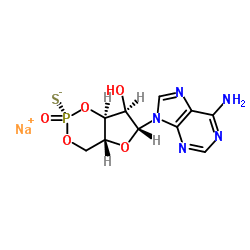142439-95-0
| Name | Sodium (2S,4aR,6R,7R,7aS)-6-(6-amino-9H-purin-9-yl)-7-hydroxytetr ahydro-4H-furo[3,2-d][1,3,2]dioxaphosphinine-2-thiolate 2-oxide |
|---|---|
| Synonyms |
Sodium (2S,4aR,6R,7R,7aS)-6-(6-amino-9H-purin-9-yl)-7-hydroxytetrahydro-4H-furo[3,2-d][1,3,2]dioxaphosphinine-2-thiolate 2-oxide
4H-Furo[3,2-d]-1,3,2-dioxaphosphorin-7-ol, 6-(6-amino-9H-purin-9-yl)tetrahydro-2-mercapto-, 2-oxide, sodium salt, (2S,4aR,6R,7R,7aS)- (1:1) |
| Description | Sp-cAMPS sodium salt, a cAMP analog, is potent activator of cAMP-dependent PKA I 和 PKA II. Sp-cAMPS sodium salt is also a potent, competitive phosphodiesterase (PDE3A) inhibitor with a Ki of 47.6 µM. Sp-cAMPS sodium salt binds the PDE10 GAF domain with an EC50 of 40 μM[1][2][3]. |
|---|---|
| Related Catalog | |
| Target |
PKA I PKA II PDE3A:47.6 μM (Ki) PDE10 GAF domain:50 μM (EC50) |
| In Vitro | Treatment of hepatocytes with Sp-cAMPS, the stimulatory diastereomer of adenosine cyclic 3',5'-phosphorothioate, mimics the response seen with glucagon. The glucagon-stimulated increases in the level of Ca2+ can be mimicked by Sp-cAMPS[4]. |
| In Vivo | In chronic alcohol consumption (CAC) mice, direct infusion of the Sp-cAMPS (1 µg/µL) into the prefrontal cortex significantly improves or impairs, respectively, working memory performance in withdrawn and water animals[5]. |
| References |
| Molecular Formula | C10H11N5NaO5PS |
|---|---|
| Molecular Weight | 367.253 |
| Exact Mass | 367.011627 |
| PSA | 182.50000 |
| LogP | 0.96900 |
